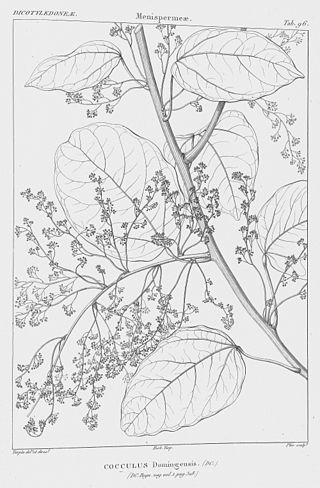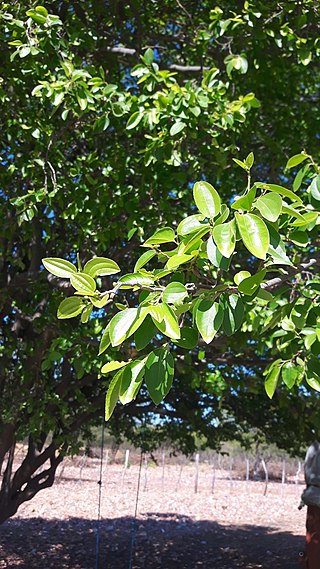
Alternanthera is a genus of flowering plants in the family Amaranthaceae. It is a widespread genus with most species occurring in the tropical Americas, and others in Asia, Africa, and Australia. Plants of the genus may be known generally as joyweeds, or Joseph's coat. Several species are notorious noxious weeds.

Bourreria is a genus of flowering plants in the borage family, Boraginaceae. Members of the genus are commonly known as strongbark or strongback. The generic name was chosen by Patrick Browne to honour German pharmacist Johann Ambrosius Beurer. The genus is native to the tropical Americas and to eastern Africa and Madagascar. American species are distributed from Mexico to northern South America, and in the Caribbean and Florida in the United States. The center of diversity is in the Caribbean, Central America, and Mexico. The eastern African species range from Ethiopia to Mozambique and to Madagascar, the Comoro Islands, and Mauritius.
Guettarda longiflora is a species of plant in the family Rubiaceae. It is endemic to Jamaica. It is threatened by habitat loss.

Halenia is a genus of plant in family Gentianaceae. It contains the following species :
Huertea cubensis is a species of plant in the family Tapisciaceae. It is found in Cuba, the Dominican Republic, and Haiti.

Hyperbaena is a genus of plants in family Menispermaceae. It includes 23 species native to the tropical Americas, ranging from Cuba and southern Mexico to northeastern Argentina.
Lunania dodecandra is a species of flowering plant in the family Salicaceae. It is endemic to Cuba.
Micropholis polita is a species of plant in the family Sapotaceae. It is endemic to Cuba, but threatened by habitat loss.
Psychotria dura is a species of flowering plant in the family Rubiaceae. It is endemic to Jamaica.
Psychotria dasyophthalma is a species of plant in the family Rubiaceae. It is endemic to Jamaica.
Rondeletia cincta is a species of plant in the family Rubiaceae. It is endemic to Jamaica. It is threatened by habitat loss.
Rondeletia glauca is a species of plant in the family Rubiaceae. It is endemic to Jamaica.

Sarcomphalus is a genus of plants in the family Rhamnaceae.
Synapsis ilicifolia is a species of plant in the family Schlegeliaceae. It is endemic to the island of Cuba. It is the sole species in the genus Synapsis, which was described as a genus in 1866.
Wallenia xylosteoides is a species of plant in the family Primulaceae. It is endemic to Jamaica. It is threatened by habitat loss.

Rondeletia is a genus of flowering plants in the family Rubiaceae. It is endemic to the Neotropics. There are around 160 species.

Voyria, commonly known as ghostplants, is a genus of 20 species of herbaceous perennial plants, belonging to the family Gentianaceae. They are mostly native to warm temperate and tropical regions of the Caribbean, Central America and South America, except for V. primuloides, which is found in West and Central Africa. V. parasitica reaches as far north as the Everglades in Florida.

Manilkara huberi, also known as masaranduba, níspero, and sapotilla, is a fruit bearing plant of the genus Manilkara of the family Sapotaceae.
Ceratopyxis is a monotypic genus of flowering plants in the family Rubiaceae. The genus contains only one species, viz. Ceratopyxis verbenaceae, which is endemic to Cuba. It is a resinous small tree or bush with 4.5-8 centimeter oblong leaves. The fruit it produces is 4-5 millimeters in diameter, and with small hairs attached to the skin.
Casasia nigrescens is a species of plant belonging to the family Rubiaceae. It is found in Cuba.







